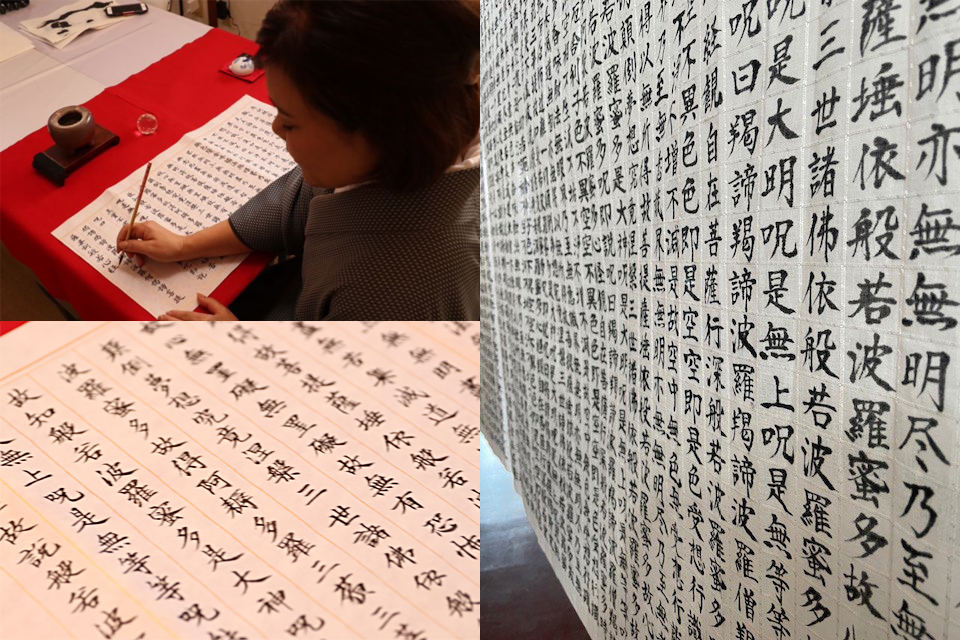Hanko Course
General information
Price: ¥20,000 (tax included) per person.
Includes:
3 Hanko*
~all items can be taken home~
*Hanko is red seal rubber stamp.
Calligraphy Kyoto is the only calligraphy studio in Kyoto where you can receive direct guidance from a professional calligrapher. Practicing meditation and mindfulness through calligraphy (Zen Calligraphy), or in this case seal carving, is effective for unifying the mind.
The carved seal is an integral part of every calligrapher’s final work. This ancient art was developed in China and brought to Japan long ago. Since early
times, calligraphers have put great importance on their seals. A well carved piece is more than a mere signature; it is voice which adds color to one’s work,
both literally and figuratively.
You can use it on your calligraphy works, on letters, etc. This will be the coolest souvenir to represent your time in Kyoto!
Detailed Course Information
1) First, choose a writing style for your design.

2) Next, practice carving simple lines.
Carving knives are very sharp so we always remind students to be careful and take their time.
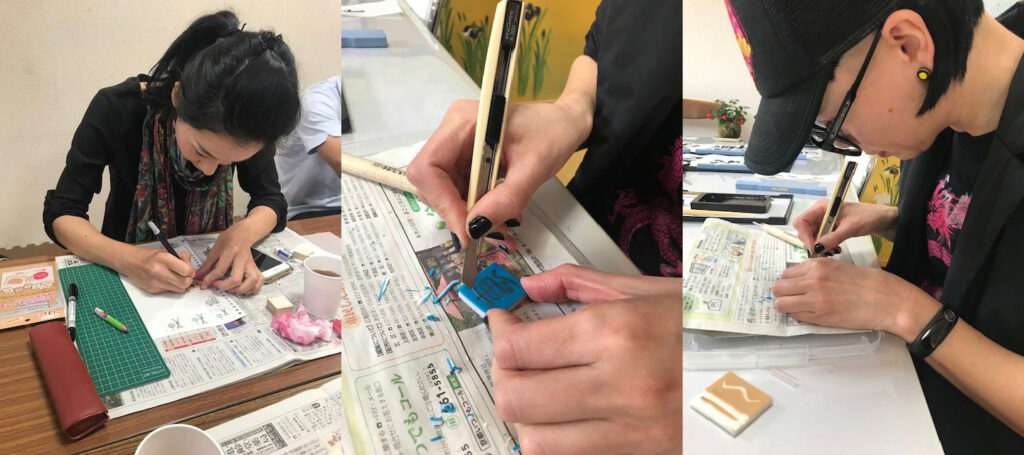
3) Next, carve your design into the rubber stamp-face.
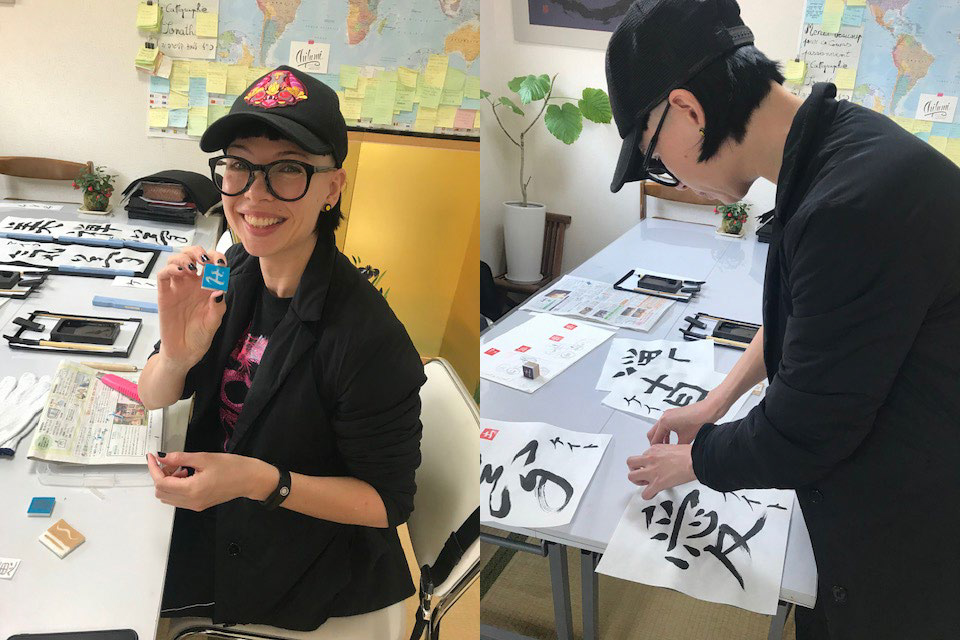
4) Finally, we can apply the ink to the stamp and make an impression. The seal that you have carved yourself is complete!
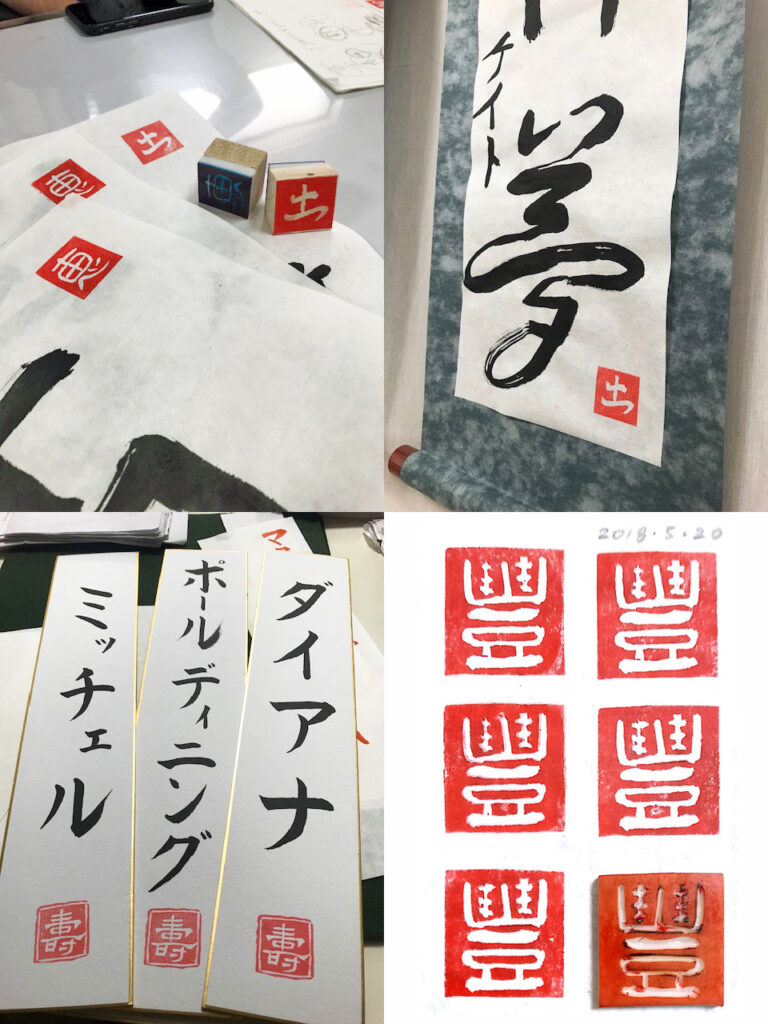
If you are interested in this course, please email to schedule a lesson.
Inkyoto7@gmail.com
Sensu Course
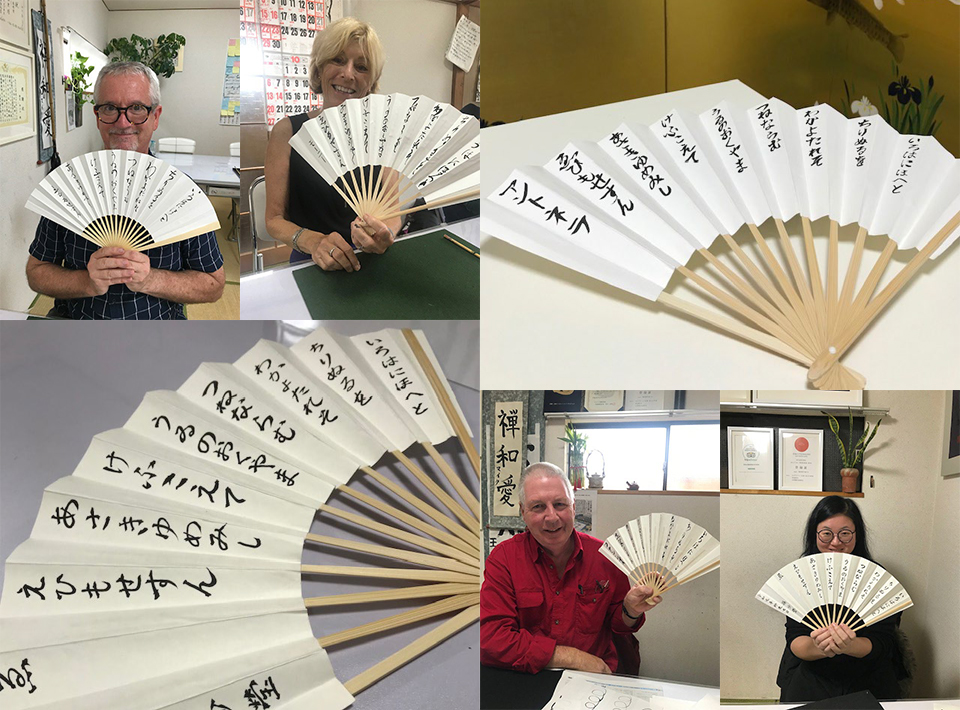
General information
Price: ¥20,000 (tax included) per person.
Includes:
1 Sensu*
1 Postcard Set (1 Japanese brush pen and 5 blank postcards)
~all items can be taken home~
*Sensu is a Japanese fan
Calligraphy Kyoto is the only calligraphy studio in Kyoto where you can receive direct guidance from a professional calligrapher. Practicing meditation and mindfulness through calligraphy (Zen Calligraphy) is effective for unifying the mind.
Kana is the term for two of the three Japanese writing systems: hiragana and katakana. Each of the 71 symbols are phonetic and don’t have a specific meaning. With a small brush, you will write a traditional Japanese poem (iroha-uta/いろは歌) on a Sensu, or Japanese fan. This will be the coolest souvenir to represent your time in Kyoto!
add sensu photos
Detailed Course Information
1) Explanation of the history of Japanese Calligraphy (Shodo) and the origins of written Japanese (Hiragana, Katakana, Kanji). Calligraphy is a traditional art form with an intimate connection to everyday life.
2) Explanation of Calligraphy tools, sumi ink preparation and how to hold the brush (fude). Calm your mind while preparing the sumi ink. As with Zen, this is a time for meditation and self-reflection.
3) Master how to handle the brush as we practice making basic lines. It is important to hold the brush vertically and control the amount of ink.
4) Let’s write kanji!
1) With your preferred hand, take the brush and hold it vertically.
2) With your other hand, hold down the washi paper.
3) Pay attention to where to place powerful strokes and where to carry the line through. Think of how to balance the characters, how to handle the brush, and the shade of the ink.
5) Now let’s try writing an iroha-uta (いろは歌) on a Sensu. It’s difficult because the fan is folded, so be careful.
Mounted in the traditional style, Sensu it is even more beautiful. Please decorate your home with it and enjoy it for many years to come.
About Iroha-uta (いろは歌)
The lyrics are written probably in the Heian period (794-1185 AD), which is famous of using all Japanese syllabaries without repeating the same character. Iroha-uta has long been used for teaching the Japanese alphabet to children.
▼ Modern translation
いろはにほへと/iro-ha-ni-ho-he-to
ちりぬるを/chi-ri-nu-ru-o
わかよたれそ/wa-ka-yo-ta-re-so
つねならむ/tsu-ne-na-ra-mu
うゐのおくやま/u-i-no-o-ku-ya-ma
けふこえて/ke-fu-ko-e-te
あさきゆめみし/a-sa-ki-yu-me-mi-shi
ゑひもせすん/e-hi-mo-se-su-n
▼ Ancient translation
色は匂へど 散りぬるを
我が世誰(たれ)ぞ 常ならむ
有為(うゐ)の奥山 今日(けふ)越えて
浅き夢見じ 酔(ゑ)ひもせず
If you are interested in this course, please email to schedule a lesson.
Inkyoto7@gmail.com
Sutra Copying Course
General information
Price: ¥20,000 (tax included) per person.
Includes:
1 Custom Sutra copy paper
26 pieces of Sutra paper
1 Brush Pen
~all items can be taken home~
Calligraphy Kyoto is the only calligraphy studio in Kyoto where you can receive direct guidance from a professional calligrapher. Practicing meditation and mindfulness through calligraphy (Zen Calligraphy) is effective for unifying the mind.
The Hannya-shingyo sutra (般若心経) is probably the most known and well loved Buddhist sutra in Japan. It is still hand-copied regularly by the Japanese people of today. Many people carry it as a charm or hand copy it in order to pray for recovery from illness. This will be the coolest souvenir to represent your time in Kyoto!
Detailed Course Information
1) Explanation of the history of Japanese Calligraphy (Shodo) and the origins of written Japanese (Hiragana, Katakana, Kanji). Calligraphy is a traditional art form with an intimate connection to everyday life.
2) Explanation of Calligraphy tools, sumi ink preparation and how to hold the brush (fude). Calm your mind while preparing the sumi ink. As with Zen, this is a time for meditation and self-reflection.
3) Master how to handle the brush as we practice making basic lines. It is important to hold the brush vertically and control the amount of ink.
4) Let’s copy a Buddhist sutra!
Put a sample copy of the sura under your paper and copy it.
The Hannya-shingyo (般若心経) Sutra
仏説摩訶般若波羅蜜多心経
(ぶっせつまか はんにゃはらみた しんぎょう)
観自在菩薩 行深般若波羅蜜多時 照見五蘊皆空
(かんじざいぼさつ ぎょうじんはんにゃはらみったじ しょうけんごうんかいくう)
度一切苦厄 舎利子 色不異空 空不異色 色即是空
(どいっさいくやく しゃりし しきふいくう くうふいしき しきそくぜくう)
空即是色 受想行識亦復如是 舎利子 是諸法空相
(くうそくぜしき じゅそうぎょうしき やくぶにょぜ しゃりし ぜしょほうくうそう)
不生不滅 不垢不浄 不増不減 是故空中
(ふしょうふめつ ふくふじょう ふぞうふげん ぜこくうちゅう)
無色 無受想行識 無眼耳鼻舌身意 無色声香味触法
(むしき むじゅそうぎょうしき むげんにびぜっしんい むしきしょうこうみそくほう)
無眼界 乃至無意識界 無無明亦 無無明尽
(むげんかい ないしむいしきかい むむみょうやく むむみょうじん)
乃至無老死 亦無老死尽 無苦集滅道 無智亦無得
(ないしむろうし やくむろうしじん むくしゅうめつどう むちやくむとく)
以無所得故 菩提薩埵 依般若波羅蜜多故
(いむしょとくこ ぼだいさつたえ はんにゃはらみったこ)
心無罣礙 無罣礙故 無有恐怖 遠離一切顛倒夢想
(しんむけいげ むけいげこ むうくふ おんりいっさいてんどうむそう)
究竟涅槃 三世諸仏 依般若波羅蜜多故
(くうぎょうねはん さんぜしょぶつ えはんにゃはらみったこ)
得阿耨多羅三藐三菩提 故知般若波羅蜜多
(とくあのくたらさんみゃくさんぼだい こちはんにゃはらみった)
是大神呪 是大明呪 是無上呪 是無等等呪
(ぜだいじんしゅ ぜだいみょうしゅ ぜむじょうしゅ ぜむとうどうしゅ)
能除一切苦 真実不虚 故説般若波羅蜜多呪
(のうじょいっさいく しんじつふこ こせつはんにゃはらみったしゅ)
即説呪日 羯諦 羯諦 波羅羯諦 波羅僧羯諦
(そくせつしゅわっ ぎゃてい ぎゃてい はらぎゃてい はらそうぎゃてい)
菩提薩婆訶 般若心経
(ぼじそわか はんにゃしんぎょう)
仏説摩訶般若波羅蜜多心経
(ぶっせつまか はんにゃはらみた しんぎょう)
観自在菩薩 行深般若波羅蜜多時 照見五蘊皆空
(かんじざいぼさつ ぎょうじんはんにゃはらみったじ しょうけんごうんかいくう)
度一切苦厄 舎利子 色不異空 空不異色 色即是空
(どいっさいくやく しゃりし しきふいくう くうふいしき しきそくぜくう)
空即是色 受想行識亦復如是 舎利子 是諸法空相
(くうそくぜしき じゅそうぎょうしき やくぶにょぜ しゃりし ぜしょほうくうそう)
不生不滅 不垢不浄 不増不減 是故空中
(ふしょうふめつ ふくふじょう ふぞうふげん ぜこくうちゅう)
無色 無受想行識 無眼耳鼻舌身意 無色声香味触法
(むしき むじゅそうぎょうしき むげんにびぜっしんい むしきしょうこうみそくほう)
無眼界 乃至無意識界 無無明亦 無無明尽
(むげんかい ないしむいしきかい むむみょうやく むむみょうじん)
乃至無老死 亦無老死尽 無苦集滅道 無智亦無得
(ないしむろうし やくむろうしじん むくしゅうめつどう むちやくむとく)
以無所得故 菩提薩埵 依般若波羅蜜多故
(いむしょとくこ ぼだいさつたえ はんにゃはらみったこ)
心無罣礙 無罣礙故 無有恐怖 遠離一切顛倒夢想
(しんむけいげ むけいげこ むうくふ おんりいっさいてんどうむそう)
究竟涅槃 三世諸仏 依般若波羅蜜多故
(くうぎょうねはん さんぜしょぶつ えはんにゃはらみったこ)
得阿耨多羅三藐三菩提 故知般若波羅蜜多
(とくあのくたらさんみゃくさんぼだい こちはんにゃはらみった)
是大神呪 是大明呪 是無上呪 是無等等呪
(ぜだいじんしゅ ぜだいみょうしゅ ぜむじょうしゅ ぜむとうどうしゅ)
能除一切苦 真実不虚 故説般若波羅蜜多呪
(のうじょいっさいく しんじつふこ こせつはんにゃはらみったしゅ)
即説呪日 羯諦 羯諦 波羅羯諦 波羅僧羯諦
(そくせつしゅわっ ぎゃてい ぎゃてい はらぎゃてい はらそうぎゃてい)
菩提薩婆訶 般若心経
(ぼじそわか はんにゃしんぎょう)
The Heart of Prajna Pramita Sutra*
When Bodhisattva Avalokiteshvara was practicing the profound Prajna Paramita, he illuminated the Five Skandhas and saw that they are all empty and he crossed beyond all suffering and difficulty.
Shariputra, form does not differ from emptiness; emptiness does not differ from form. Form itself is emptiness; emptiness itself is form. So too are feeling, cognition, formation, and consciousness.
Shariputra, all Dharmas are empty of characterisitcs. They are not produced, not destroyed, not defiled, not pure; and they neither increase nor diminish. Therefore, in emptiness there is no form, feeling, cognition, formtion, or consciousness; no eyes, ears, nose, tongue, body, or mind; no sights, sounds, smells, tastes, objects of touch, or Dharmas; no field of the eyes up to and including no field of mind consciousness; and no ignorance or ending of ignorance, up to and including no old age and death or ending of old age and death. There is no suffering, no accummulating, no extinction, and no Way, and no understanding and no attaining.
Because nothing is attained, Bodhisattva through reliance on Prajna Pramita is unimpeded in his mind. Because there is no impediment, he is not afraid, and he leaves distorted dream-thinking far behind. Ultimately Nirvana! All Buddhas of the three periods of time attain Anuttara-samyak-sambodhi through reliance on Prajna Paramita. Therefore, know that Prajna Paramitta is a Great Mantra, a Great Bright Mantra, a Supreme Mantra, an Unequalled Mantra. It can remove all suffering; it is genuine and not false. That is why the Mantra of Prajna Paramitta was spoken. Recite it like this:
Gaté Gaté Paragaté Prasamgaté Bodhi Svaha!
End of The Heart of Prajna Paramita Sutra
(From Buddhist Text Translation Society)
If you are interested in this course, please email to schedule a lesson.
Inkyoto7@gmail.com


